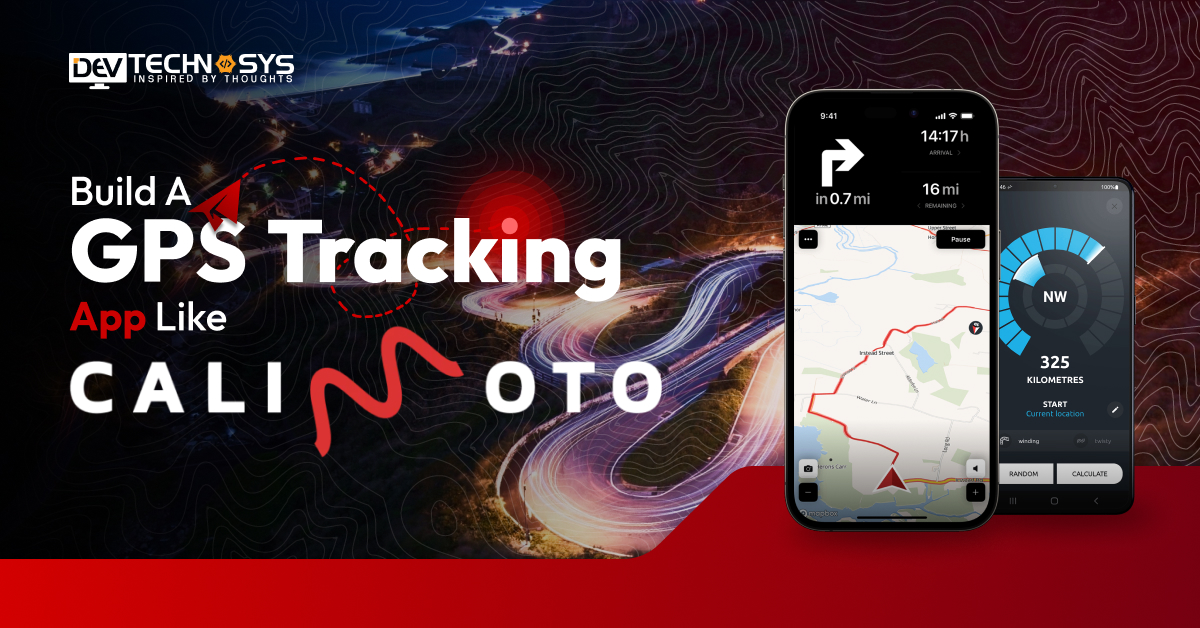Have you ever wondered how much it cost to make an e-commerce website? I know I did when I first started my online store. Investing significant money without knowing the exact costs can be daunting.
But fear not!
In this blog, I’ll summarize the factors influencing e-commerce website development costs and give you a realistic estimate.
I’ll explore the components involved, from design and development to hosting and maintenance.
So, if you’re a budding entrepreneur or an established business looking to expand online. In that case, this blog will provide valuable insights to help you make informed decisions about your e-commerce website project.
What is an Ecommerce Website?
An eCommerce website is a web-based platform that enables businesses to sell goods or services to clients through the internet. It functions as a virtual storefront, allowing customers to explore, search for, and purchase things from the comfort of their own homes.
Product catalogs, shopping carts, secure payment gateways, and order processing systems are all vital components of eCommerce websites. Businesses may use them to reach a worldwide audience, provide tailored purchasing experiences, and track customer preferences and behavior.
With the increasing popularity of online purchasing, eCommerce websites have become an essential component of modern retail. It provides a smooth and effective means of conducting digital commerce.Implementing an NDA for app development. This ensures that sensitive information and proprietary ideas are protected throughout the development process.
Market Stats of Ecommerce Website

- Global retail e-commerce sales were estimated to be at 5.2 trillion dollars in 2021. By 2026, this amount is expected to have increased by 56%, totaling roughly 8.1 trillion dollars.
- In 2023, the eCommerce market is anticipated to generate US$3.64 trillion in revenue.
- By 2027, it is anticipated that revenue would expand at an 11.16% annual rate (CAGR 2023–2027), with a market size of US$5.56 trillion.
- The largest market volume, estimated at US$1,319.00 billion in 2023, is produced in China
- By 2027, there should be 5.29 billion users active in the eCommerce market.
- User penetration is projected to reach 57.2% in 2023 and 66.6% in 2027.
- It is anticipated that the average revenue per user (ARPU) will be $827.40 USD.
Why Do Entrepreneurs Make E-Commerce Websites?
E-commerce is becoming a more excellent and famous alternative for entrepreneurs looking to develop their businesses and construct a robust online presence. Here are five robust reasons for their choice to create an ecommerce website, together with a viable return on investment to attract traders:
1. Global Reach and Market Expansion
Overcoming Nearby Barriers:
Businesses can now access clients anywhere in the world through e-trade websites, which overcome the restrictions of offline stories. A PWA web development company can enhance this international reach, creating new boom potentialities and markets.
ROI Benefit:
Companies that can increase and take market shares are more attractive to investors. Targeting a global audience allows e-commerce websites to provide sizable growth capacity.
2. 24/7 Accessibility and Convenience
Customer Comfort:
Online retailers give their customers the freedom to save on every occasion and wherever it suits them best, as they may be continuously open. More incredible customer pride and loyalty could result from this accessibility.
ROI Benefit:
Convenient purchasing can boost consumer lifetime fees and encourage repeat enterprise. CodeIgniter web development services that have the potential to broaden committed shoppers and produce consistent streams of profits are attractive to investors.
3. Cost-Effective Operations
Reduced Overhead Costs:
E-commerce websites sometimes have cheaper running costs than standard brick-and-mortar establishments. This can involve lowering the need for staffing, utilities, and rent.
ROI Benefits:
Reducing running charges can enhance an enterprise’s profitability and attract more investors. Businesses with proper monetary performance are more likely to receive backing from traders.
4. Data-Driven Decision Making
Valuable Insights:
Businesses can obtain useful statistics about user conduct, alternatives, and buy developments from e-commerce systems. Partnering with an ewallet development company enables knowledgeable judgments concerning product services, marketing approaches, and stock management, which are viable with the use of these facts.
ROI Benefits:
More powerful marketing and more green operations can result from information-driven choice-making. Businesses that can use data to streamline operations and spur growth are attractive to buyers.
5. Enhanced Brand Awareness and Engagement
Opportunities For Digital Advertising:
E-commerce websites offer companies a method for interacting with customers through electronic mail advertising, social media advertising. However, content marketing, among other virtual advertising and marketing channels.
ROI Benefits:
Companies that use effective digital advertising and marketing can boost customer involvement, increase logo popularity, and enhance traffic to their online stores. Investors are interested in agencies with a sturdy brand reputation and the ability to connect with their target market.
How Much Does It Cost to Make an E-commerce Website?
The cost to make an e-commerce website might vary greatly based on some variables. These factors include the website’s complexity, the location of the full stack web development companies, the platform applied for e-commerce, the design and user experience (UX), backend development, advertising and marketing and advertising, and maintenance.
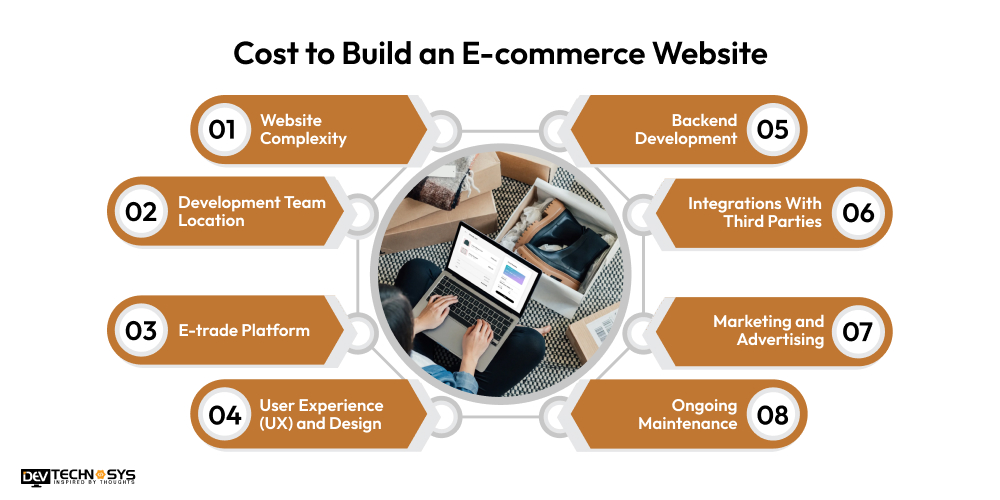
1. Website Complexity:
The number of capabilities and functionalities a website may have determines its degree of complexity, increasing the cost of making an e-commerce website.
Building an accessible website with few products and a trustworthy checkout procedure can be less luxurious than constructing a complex website. With an extensive product catalog, several charge techniques, and complicated functions like recommendation engines and personalization.
Website Type |
Cost Range |
| Basic E-Commerce Website (Few Products, Simple Checkout) | $8,000 – $12,000 |
| Intermediate E-Commerce Website (Medium Catalog, Multiple Payment Methods) | $12,000 – $20,000 |
| Complex E-Commerce Website (Large Catalog, Advanced Features) | $20,000 – $30,000 |
2. Development Team Location:
The location of the eCommerce web development company will affect the cost of making an e-commerce website. Ecommerce website development company from affluent countries, consisting of America and Western Europe, usually have ecommerce website development costs greater than Ecommerce website development company from developing international locations, along with the Philippines and India.
Location of Development Team |
Cost Range |
| India, Philippines (Developing Countries) | $8,000 – $15,000 |
| Eastern Europe | $15,000 – $22,000 |
| USA, Western Europe | $22,000 – $30,000 |
3. E-trade Platform:
There are several options for e-commerce structures, each with a unique cost to make an e-commerce website shape. While a few platforms have a one-time or monthly rate, others are loose to apply. The capabilities you require and the size of your enterprise will determine the platform’s fee, resulting in increasing ecommerce website development costs.
E-Commerce Platform |
Cost Range |
| Open Source (e.g., WooCommerce, Magento) | $8,000 – $15,000 |
| SaaS Platforms (e.g., Shopify, BigCommerce) | $15,000 – $20,000 |
| Custom-Built Platform | $20,000 – $30,000 |
4. User Experience (UX) and Design:
Attracting and converting traffic to your internet site relies upon its design and user experience. A website with proper design will be more accessible to use and read with the help of e-commerce website design services. It increases the cost of make an e-commerce website, even though.
Design Complexity |
Cost Range |
| Basic UX/UI Design | $8,000 – $12,000 |
| Customized UX/UI Design with Some Custom Features | $12,000 – $20,000 |
| Fully Customized UX/UI Design with Premium Features | $20,000 – $30,000 |
5. Backend Development:
Making your website server side is referred to as backend development. This covers the charge processing, buying cart, and database. The intricacy of your website will determine how much the backend costs to make an e-commerce website.
Backend Development Complexity |
Cost Range |
| Basic Backend Development (Simple Cart, Payment System) | $8,000 – $12,000 |
| Intermediate Backend (Advanced Cart, Secure Payment System, Database) | $12,000 – $20,000 |
| Advanced Backend (Custom Server Integration, High Security) | $20,000 – $30,000 |
6. Integrations with Third Parties:
Your website must be integrated with third party services like advertising equipment, delivery corporations, and payment gateway integration. The cost to build an e-commerce website for these integrations will vary depending on the particular offerings you require.
Third-Party Integration Type |
Cost Range |
| Basic Integrations (Payment Gateway, Basic Shipping) | $8,000 – $12,000 |
| Intermediate Integrations (Multiple Gateways, Advanced Shipping, CRM) | $12,000 – $20,000 |
| Complex Integrations (Advanced Logistics, ERP Systems) | $20,000 – $30,000 |
7. Marketing and Advertising:
To draw traffic to your website after it’s been created, you must promote it. Search engine optimization (search engine optimization), email email advertising, social media advertising, and paid advertising are some examples of this.
Depending on your cost to build an e-commerce website range and advertising goals, the value of advertising and marketing and advertising will change.
Marketing Strategy |
Cost Range |
| Basic SEO and Social Media Marketing | $8,000 – $12,000 |
| Intermediate Paid Ads and Email Marketing | $12,000 – $20,000 |
| Full-Scale Marketing Campaigns (SEO, PPC, Social Ads) | $20,000 – $30,000 |
8. Ongoing Maintenance:
Following the release of your website, you’ll want to continue updating and maintenance. This covers computer virus maintenance, content updates, and protection updates. The size and complexity of your website will affect the cost of continuous maintenance.
Maintenance Level |
Cost Range |
| Basic Maintenance (Updates, Security Patches) | $1,000 – $5,000/year |
| Intermediate Maintenance (Minor Feature Updates, Bug Fixes) | $5,000 – $8,000/year |
| Full Maintenance (Continuous Support, Feature Enhancements) | $8,000 – $12,000/year |
The cost of making an e-commerce website will vary depending on your particular needs and the development schedule in addition to the formerly stated concerns. Obtaining estimates on the cost to build an e-commerce website from diverse e-commerce website development services is crucial prior to you deciding.
12 Must-Have Advanced Features of E-Commerce Websites That Affect Cost
The cost to build an e-commerce website requires a massive budgetary list, which varies greatly depending on the functions you select. These 12 complex capabilities can extensively affect the cost to create an e-commerce website:
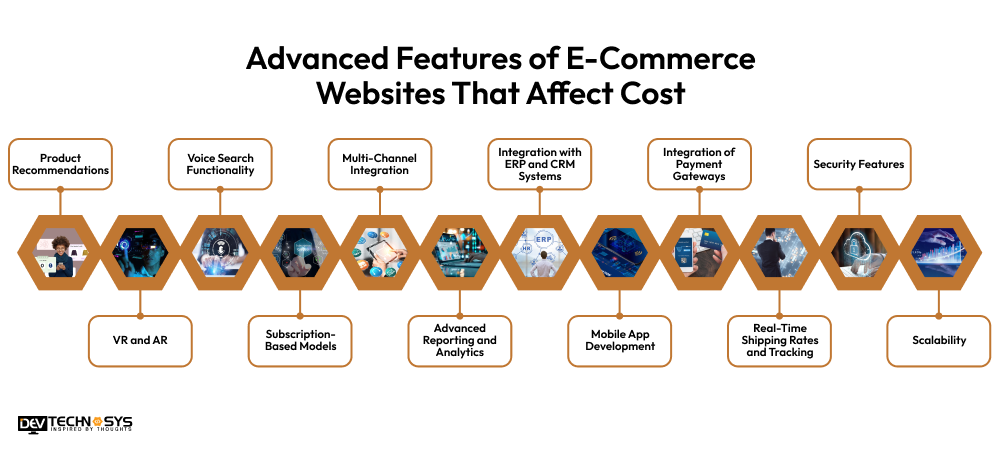
1. Personalized Product Recommendations
While using AI-powered algorithms to create product pointers based on user conduct and options can improve consumer experience, it comes with more CMS web development and maintenance costs.
2. Virtual Reality (VR) and Augmented Reality (AR)
Virtual reality and augmented reality can offer attractive buying stories, as they want unique hardware and software.
3. Voice Search Functionality:
Adding voice search functionality can increase accessibility, but it will also increase the cost to develop an ecommerce website and interact with speech popularity APIs.
4. Subscription-Based Models:
Subscription-based merchandise can generate a consistent income stream, but doing so requires an advanced device for handling subscriptions and additional merchandising. Partnering with an online shopping app development company can streamline this process effectively.
5. Multi-Channel Integration:
Reach can be elevated by integrating with other sales channels (including social media and marketplaces). However, doing so may incur extra costs and technological complexity to make an e-commerce website.
6. Advanced Reporting and Analytics:
Extensive analytics tools may include accelerated license charges. However, they can provide insightful data for improving the website, which will result in increasing cost for ecommerce website development.
7. Integration With ERP and CRM Systems:
Linking your e-commerce platform to modern company structures would enhance efficiency but require technological connections and a high cost to make an e-commerce website.
8. Mobile App Development:
Although it includes higher development and maintenance fees, creating a specialized mobile app can improve user revel in and engagement, increasing the cost of e-commerce website development.
9. Integration of Payment Gateways:
While integrating with numerous payment gateway integrations can increase client comfort, there can be associated prices and transaction fees.
10. Real-Time Shipping Rates and Tracking:
Integrating with shipping vendors is essential to offer clients up-to-date shipment statistics, which could enhance purchaser pride.
11. Security Features:
Robust security features such as fraud detection and SSL certificates) are essential to defending user statistics and can improve e-commerce website development costs and renovation charges.
12. Scalability:
You want a scalable architecture to ensure your web portal development can grow and manage extra traffic. This may mean paying extra for website hosting and making adjustments in the future.
Types of E-Commerce Websites That Affect the Cost
Before we learn about the cost to develop an e-commerce website we must know about its different types. Yes you heard it right knowing about the cost to make an ecommerce website isn’t completed without understanding its type because it affects the entire cost.
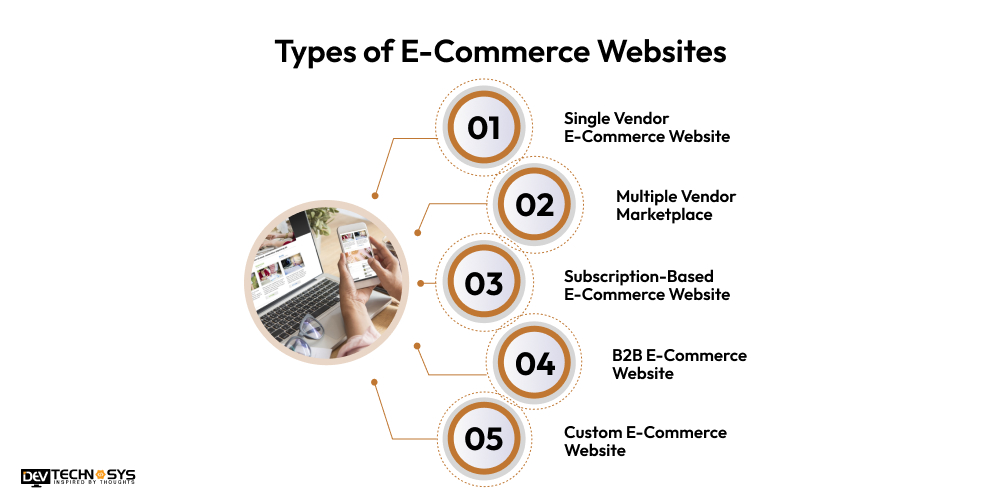
1. Single Vendor E-Commerce Website
A simple platform wherein all orders, products, and the shop are managed by a single dealer. These are perfect for small organizations as they’re less expensive and less complicated to maintain.
2. Multiple Vendor Marketplace
On a single platform, several traders can list and sell goods (like Amazon). It increases the cost to develop an ecommerce website extra to design these, considering they want more sophisticated features like commission monitoring, payment gateways, and dealer control.
3. Subscription-Based E-Commerce Website
Consumers need to pay on an everyday basis to access sure items and offerings (like Dollar Shave Club or Netflix). Impacts cost to make an e-commerce website because it necessitates content material/product supply and ongoing payment integration.
4. B2B E-Commerce Website
Businesses that operate B2B e-trade websites promote items and services to different companies. The platform is more complex and pricey than B2C websites since it needs capabilities for large orders, stable login, and customized pricing.
5. Custom E-Commerce Website
Completely customized e-trade websites made from the floor up by commercial enterprise desires. Although those are very scalable and versatile, the custom capabilities and layout increase the cost to make an e-commerce website.
6 Ways to Reduce the Cost to Create An E-Commerce Website
It is important to reduce the shopping app for your e-commerce business. Establishing an online save may additionally require a sizable monetary dedication. Nonetheless, there are some approaches to reducing the cost to make an e-commerce website without sacrificing first-rate or functionality:
1. Select an Easy-to-Use Platform:
Invest in a prepared-made e-commerce platform like Magento, WooCommerce, or Shopify. By presenting payment gateways, SEO equipment, and configurable issues, these structures reduce the want for comp licated custom programming.
2. Set Important Features in Order of Priority:
Pay attention to the important features that your organization requires. Steer clear of extraneous functions that might increase eCommerce app development costs. Start by focusing on the necessities, such as secure checkout, buying carts, and product listings.
3. Make Use of Low-Cost or Free Tools:
Use low-fee or free equipment for analytics, advertising and marketing, and design. Online sources abound; some examples are Mail chimp for email email advertising, Google Analytics for monitoring, and Canva for design.
4. Optimize Your Website For Mobile:
Make sure your simple e-commerce website works on mobile gadgets. Using smartphones and tablets for internet purchasing is very commonplace. Without incurring a greater cost to make an e-commerce website, you may amplify your target market by using mobile-specific topics or responsive design.
5. Outsource Non-Core Tasks:
Consider outsourcing internet design, programming, or search engine optimization in case you do not have enough time or experience particular regions. By attracting experts with specific know-how, you could reduce time and cost to develop an ecommerce website.
6. Outsourcing Ecommerce Partner
Outsourcing to an e-commerce app development company reduces costs through access to specialized expertise, efficient processes, and economies of scale. It is vital to know that online marketplace development company enable quicker delivery and minimize overhead expenses while maintaining high-quality standards.
7 Ways E-Commerce Websites Make Money
After spending money to develop an e-commerce website, you must want to know how to generate revenue. E-commerce websites, with their accessibility and comfort, have entirely modified the way we shop. However, how do those websites make money? Let’s look at the seven predominant revenue streams for e-commerce websites.
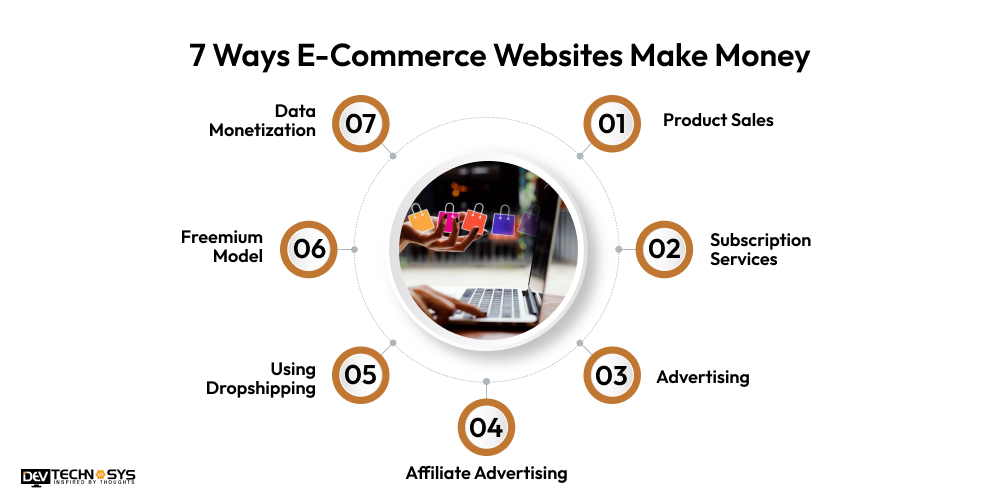
1. Product Sales
The handiest sales version is this one. E-commerce websites allow clients to purchase digital or bodily items without delay. Custom website development services can enhance these platforms, ensuring a tailored experience for users and streamlined operations for sellers.
2. Subscription Services
Subscription-based services are broadly available on e-commerce websites, giving customers daily access to merchandise or content. The beauty, fashion, food, and streaming offerings industries use this method extensively, and it is another way to get a return on your e-commerce website development cost.
3. Advertising
You must create online shopping apps like Shopee. These could make money by displaying ads, as conventional media. These could be backed material, pop-ups, or banners. Advertisers can attain a selected audience by using purchasing visibility on the website.
4. Affiliate Advertising
E-commerce websites collaborate with other groups in associate advertising to promote their products and services. The website gets a fee when a user uses the associate hyperlink to make a purchase.
5. Using Dropshipping
With drop shipping, the best e-commerce apps do not keep stock accessible. Instead, they collaborate with vendors who deliver merchandise directly to clients. The gap between the product’s price and promotion rate is how the website makes money.
6. Freemium Model
Under this approach, a primary model of the good or provider is furnished free. However, more functions or top-rate features may be available at a charge. It’s a commonplace tactic to attract an enormous user base before getting cash off of a part of the clients.
7. Data Monetization
E-commerce websites gather many user statistics, such as demographics, preferences, and purchases. Businesses can also find these records beneficial for focused advertising, market research, and customized suggestions. Certain websites might make money by promoting these statistics to unaffiliated companies.
Tech Stack For E-Commerce Website Development
Component |
Technologies |
| Frontend | React Native, Flutter, Swift, Kotlin |
| Backend |
Node.js, Java (Spring Boot) Python (Django/Flask), |
| API Integration | GraphQL, RESTful APIs, SOAP |
| Database | SQLite, PostgreSQL,MySQL, MongoDB, Firebase |
| Analytics | Google Analytics, Firebase Analytics |
| Authentication | OAuth, JWT |
| Push Notifications | Apple Push Notification Service, Firebase Cloud Messaging |
| Version Control | Git, GitHub, Bitbucket |
| Deployment | Apple App Store, Google Play Store, TestFlight, Firebase App Distribution |
Start Selling Today!
With more than 14 years of experience, Dev Technosys is a top e-commerce website development company that offers affordable prices to create an e-commerce website. Our skilled developers can design a unique website that fits your dreams and budget. We also offer continuous maintenance and support to keep your website current and valid.
If you want to start developing your e-commerce website, contact us right now. Our e-commerce website developer can confirm your business enterprise’s goals and devise a strategy for constructing a website to help you accomplish them.
Frequently Asked Questions
1. How Much Does It Cost to Develop an ECommerce Website?
The cost to develop an ecommerce website depends on design complexity, features, integrations, and platform choice. Depending on the scale and customizations needed for your specific business, it can range from $8,000 to $30,000 or more.
2. How Long Does It Take To Make an E-Commerce Website?
Development timelines vary from 3 to 6 months, depending on the scope, design, and functionality requirements. More complex websites with custom features may take longer, involving several iterations and testing phases.
3. What Are The Benefits of Making an E-Commerce Website?
- 24/7 sales and customer access
- Global reach for products and services
- Cost-effective business expansion
- Enhanced customer engagement and data collection
- Simplifies inventory and order management
4. Why Should You Choose Us To Make an E-Commerce Website?
- Expert team with proven experience
- Customized solutions tailored to your business needs
- Focus on user experience and scalability
- Support for multiple payment gateways and integrations
- Comprehensive post-launch support and maintenance
5. How Can You Monetize an E-Commerce Website?
- Product sales and subscriptions
- Advertising and affiliate marketing
- Paid memberships for exclusive content or discounts
- Sponsored content or partnerships
- Upselling and cross-selling opportunities
6. How Much Will It Cost To Maintain Your E-Commerce Website?
Maintenance costs range from $2000 to $5,000 per month depending on updates, security, hosting, and feature enhancements. It includes server upkeep, bug fixes, performance optimization, and ensuring a smooth customer experience.






















